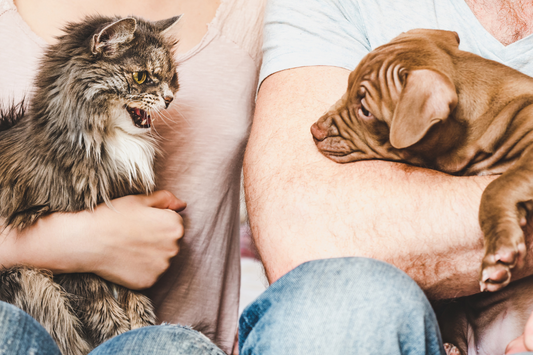New Puppy!
Bringing home your new puppy is an exciting time, but can also be overwhelming for both you and your pup. However, there’s lots of things you can do to make your pet’s arrival go as smoothly as possible:
Jump to urgent help or have a read through our article for top tips and support:
Tips for well behaved puppies…
- Do allow your puppy to explore their new surroundings in their own time. Don’t force them into situations that they may find overwhelming and provide a quiet place that they can escape to if they wish.
- Do set ground rules – they may be cute but if you don’t want them on the settee or bed when they are older then don’t let them get on when they are young. Remember also that the tiny pup that cuddles up on your lap now may grow into a weighty adult.
- Do be consistent. Everyone involved must stick to the same rules and routine whenever possible.
- Do provide lots of toys for your puppy. These will provide great stimulus for times when you are busy or not around.
- Do take time to introduce your puppy to lots of different sights (bicycles/horses/wheelchairs), sounds (vacuum cleaner/traffic noise/school playground), people (old/young/with hats!) and experiences (cars/bridges/pelican crossings) so that these become routine and your pup will not be fearful of them in later life. The range is endless but well socialised puppies rarely develop behavioural problems.
- Do regularly examine between toes, through coats and in mouths and ears. It will help you monitor the health of your pup and also make it much easier to give worm tablets or treat any problems in later life.
- Do exercise your puppy regularly – it will do you both good! If you need guidelines as to what is appropriate at each age please talk to one of the nurses.
- Do start training early – continuously praise and reward good behaviour and if possible enrol your pup in puppy classes.
- Don’t reprimand your puppy for naughty acts that happened in your absence. He will misunderstand and become fearful of you.
- Don’t leave young children alone with any dog.
- Do try to learn to recognise your puppy’s body language. Being able to work out if they are happy, sad or uncomfortable will make training much easier.
- Do remember that any changes in your life or routine will also affect your puppy.
Time to sleep

At the beginning, our homes can seem big and strange to new pups. Creating a safe space for them to retreat to is important in helping them settle. Using a crate can help give your pup a space they can feel safe and secure in. Make it nice and cosy in a quiet area of the house, with a snuggly blanket, water bowl and a soothing toy to help create a calm chill out zone. Puppies need to sleep up to 18-20 hours per day, so having a set place creates a good routine for them to follow.
What can I do if my puppy cries?
Your may puppy cry because they have been separated from their mum and siblings. This can be very stressful at times. There are a few tips that you can do to help your puppy feel more comfortable in his new home.
First of all, every puppy needs exercise. Make sure you take him out for walks and play with him during the day so that he can burn all that energy. Regular walks also help build your puppy’s confidence over time. Keep him busy and give him something to do. A good rule of thumb is 5 minutes of exercise per month of age, up to twice a day. You can also keep him entertained with chews and toys to help keep him mentally stimulated.
Secondly, put a blanket or an old T-shirt that has your smell into his crate or bed. This also helps when you are not in the house as your puppy will find the comfort of your smell and settle down. Puppy loves toys so it will help if you can throw in the crate his favourite toy (you can wrap the toy inside the T-shirt). If you have a wire crate, you can cover this with a blanket to calm him down. Alternatively, you can position the crate in a dark area if this helps.
Thirdly, if he still cries after a while, you can take him out, hold him, walk around the house & comfort him. Don’t overdo this as he will learn that his crying gets your attention and continue to cry even more!
Lastly, if all of the above still does not work. You have to be firm and ignore his crying. Let him cry and go to sleep. Make sure that he’s been fed and has his water beside. Do not return when he cries! Make sure you are consistent with the rules!
Puppy biting

All puppies use play biting when they are excited. This is because they haven’t yet learned to play appropriately. Unfortunately, sometimes we come across older dogs that are still play biting. Often these dogs have been encouraged to rough and tumble with their owners and haven’t been taught to focus on toys. It is sensible to stop all play that involves your puppy being rough or using its mouth on hands or clothing. Try to predict when your dog is about to make a mistake and stop the game. It is important to teach your dog that playing roughly means an end to the ‘game’.
Top tips
- Encourage games with large toys or items that your dog likes to hold in its mouth.
- Teaching all the basic commands is helpful as if your dog becomes overly excited you can then use the “Leave” command or a “Sit” or “Down” to regain some control.
- Short play times are helpful and encourage your dog to play with other toys independently so that he can have fun and entertain himself without you.
- Make sure that you exercise your dog properly so that excessive energy doesn’t lead to mistakes when playing.
- Always supervise play with children as they often get overly excited and this leads to a dog making a mistake.
How can I teach my puppy to play?

All puppies like to play games; either by themselves, with their owner or with another puppy. Playing helps to keep the puppy entertained as well as helping him to stay fit and develop skills such as good coordination and manners. Another benefit to puppies is that chewing on a toy can help them through the teething stage.
Top tips:
- Having toys to chew on can help to prevent inappropriate chewing on your possessions. Puppy Nylabones are a great choice to help soothe teething gums and teach appropriate chewing habits.
- Have a good range of toy types and materials – soft cuddlies, balls, and tugs. Puppies have to learn to play with toys so you should spend time encouraging your puppy to play with his toys. He will need a range so that he has something to suit any mood.
- Offer your puppy toys that are sized appropriately for him and take away and replace damaged toys. Your encouragement will play an important part in his choices of play item.
- If your puppy is unfamiliar with playing or is timid, you might have to take time slowly teaching him to play. Get onto the floor and wiggle his toy at floor level. Small, quick movements are ideal to evoke some interest from your puppy. Praise him well when he begins to play.
Do I need to socialise my puppy?

Puppies all need to be well socialised and learn to be confident with other dogs, people and different environments. The most common cause of fear and aggression is lack of suitable socialisation.
Puppy socialisation involves meeting and having pleasant encounters with many adults, children and dogs starting during their early weeks of puppyhood and continuing until adulthood. These sessions must be done daily but care should be taken never to overwhelm your puppy or kitten while you try to socialise it.
If you fail to socialise your pet within the first few weeks (prior to 12 weeks) then unfortunately your pet will be significantly more likely to have fear or anxiety based problems later in life.
How can I introduce my new puppy or kitten to my other pets?
Great care should be taken when introducing any new puppy or kitten to resident pets. Firstly, you must create a safe and controlled situation. It is usually better if you have an extra pair of hands to help you during the first introductions so that you can stay calm and deal with any situation that arises.
Your adult dog should wear a lead for safety but do not allow your puppy to pester the adult since it would then be natural for the adult to reprimand the youngster. Praise your adult for tolerating the puppy and remember to give them plenty of breaks so that they don’t become tired of one another. Use a puppy crate or child gate to create space between them when you are not able to supervise.
Adult cats can be very perturbed when a kitten is brought home. It is often best to let your kitten settle in one room first and to allow your adult to get used to the smell of your kitten via blankets or toys. Slow introductions are much better than suddenly forcing the cat and kitten to be in the same room together. Try to distract with wand toys and a selection of other kitty toys. Either cat should have options to escape from the other if they feel worried. Provision of cat carriers or cardboard boxes can help to create hiding places.
When introducing to other pets, care should always be taken. Never allow your puppy or kitten to chase small pets since this is likely to become dangerous as they grow larger. It can also cause a great deal of stress to the other pet.
Puppy training – when and how to get started?

Encouraging your puppy to engage with you is the first part of their training and it’s never too soon to start!
Clicker training is a positive training method that identifies and rewards desirable animal beh3aviours, encouraging them to be learned and repeated. It’s a great way to teach your pup new things, be that basic commands or fun tricks. Your pup learns to understand that the sound of the click means “that’s right” and that a reward is coming. It’s a great way to motivate them and keep their attention. Clicker Training Read More.
How and when to start grooming your pup?

Grooming and handling your puppy is essential for maintaining their physical health and wellbeing – becoming accustomed to this as early as possible will make this part of their routines stress free and enjoyable. This is essential for longer-haired breeds which will need to be groomed regularly to stay matt-free. Waiting until they are older, may make it almost impossible to complete grooming routines, especially nail clipping and ear cleaning. Puppy & Kitten Grooming Read more.






